#Gorilla Sapiens
Text
eris (e gorilla sapiens) al vintage market, roma, fino al 4 dicembre
eris (e gorilla sapiens) al vintage market, roma, fino al 4 dicembre
Via Tuscolana 179, Roma
vintagemarketroma.it

View On WordPress
#Edizioni Gorilla Sapiens#Eris#Eris Edizioni#Gorilla Sapiens#Gorilla Sapiens Editore#libri#VintageMarket
0 notes
Text

A chart showing the divergence on the evolutionary timeline of humans and gorillas, chimps etc from our common ancestors
#evolution#graphic#Homo sapiens#apes#chimpanzees#gorilla#bonobos#Neanderthals#Homo erectus#millions of years#data#science
44 notes
·
View notes
Text
HUMAN EVOLUTION
Homo Habilis, homo Erectus, and Homo Neanderthals are the names of some species that were the closest ancestors of humans. Humans have some special relatives called Great Apes. These include chimpanzees, gorillas, orangutans, and us, humans. We all belong to a scientific group called Hominids. One thing that makes us similar is that none of us have a tail. Now, here's something interesting: gorillas and orangutans can walk on two legs like humans, even though they usually walk on all fours. We also share the same blood group types across all Hominids. So, in a nutshell, we humans have some close cousins in the Great Ape family, and we share some common traits with them, like no tails and similar blood groups.
even though Great Apes can't talk like we do, they can understand human sign language, which is pretty cool. Plus, when we tickle them, they make sounds that are a lot like laughter, just like us! Now, the reason for all these similarities is because we share a lot of our genetic material. For instance, humans and chimpanzees have a super high 99% similarity in their DNA. Gorillas come next, with 98% of their DNA matching ours. And our third cousins, the orangutans, share about 97% of their DNA with us. So, these genetic connections explain why we have so much in common with these Great Apes.
In the group of Hominids, which includes humans and Great Apes, we also have some smaller apes called gibbons. There are about 20 different species of gibbons. These gibbons share about 96% of their DNA with humans, which is quite a lot. Now, when we talk about Hominoids, that's a bigger group that includes all of us without tails, like humans, Great Apes, and these gibbons. One interesting thing about Hominoids is that we all have a special vision called trichromatic colour vision, which helps us see lots of different colors. So, no tails and colorful vision are things we all have in common in this big family.
Now, if we take a step back, we have a bigger group called Anthropoids. In this group, we have both monkeys and apes. There are 130 different types of old-world monkeys and 120 types of new-world monkeys that are still around today. So, it's a pretty diverse bunch of primates in this category.
If we go even further back, we reach a group called "primates." In this group, we have not only monkeys and apes but also creatures like Tarsiers and Lemurs. These two are known as "prosimians," which means they are like early versions of monkeys. Tarsiers are animals that are sensitive to daylight, while lemurs are quite interesting because there are over 100 different types of them. Lemurs are actually the oldest primates in the world. Now, when we look at all primates, we notice some common things. One is that all primates have hands that can grab and hold things. We humans are a great example of this. But here's a neat thing: other primates, besides humans, can also use their feet to grab things. So, they have grasping feet! Another cool fact is that all primates have big brains, which makes them smart creatures. So, whether it's using their hands, feet, or their brains, primates are a fascinating group of animals.
All primates, like monkeys, apes, and humans, like to live together in groups. They do this because they enjoy being around others and have complex ways of interacting with each other. Now, when it comes to smelling things, primates aren't very good at it. Compared to some other animals like dogs, our sense of smell isn't that great. Dogs, for example, have an amazing sense of smell, way better than ours. So, smelling things is not our strong suit, but we make up for it in other ways with our social behaviors.
Around 60 million years ago, scientists think that primates first appeared. In 2012, they found some ancient fossils in Montana that were about 65 million years old. These fossils belonged to a creature that looked a bit like a mouse, and it was named Purgatorius. This little guy is believed to be the oldest primate ever discovered. Now, one thing about primates is that they're really good at climbing trees. That's why they're often called "arboreal." A scientist named Jonathan Block has a theory that there might be a connection between the evolution of primates and the plants around during that time. So, it's possible that the environment and the plants had something to do with how primates evolved.
Around 25 million years ago, something interesting happened in the evolution of primates. This is when hominoids came into the picture, and some primates started losing their tails. The earliest ancestor of humans without a tail was a primate called Proconsul. This change happened because of a mutation in a gene called TBXT. Now, why did this happen? Well, it's thought that some primates began to walk on two legs instead of four. Tails are handy for hanging onto trees, but when we're walking upright on two legs, they can get in the way. This way of moving on two legs is called "bipedalism." The very first ancestor of humans to walk on two legs was Ardipithecus Ramidus, who lived about 4.4 million years ago. However, when scientists looked at their skeletons, they realized that they didn't always walk on two legs. They figured this out by studying the bones and how they differed from those of humans. So, while they could walk on two legs, it wasn't their main way of getting around.
Around 3.7 to 3 million years ago, there was a species called Australopithecus Afarensis. These guys were special because they always walked on two legs, making them committed bipeds. In 1974, in Ethiopia, they found a famous fossil of an Australopithecus named Lucy. What's really cool is that they found a bunch of skeletons in one place, which gave us a lot of information. Australopithecus still had long and strong hands, which is interesting. The oldest stone tools made by our ancestors were discovered in Kenya, and they were about 3.3 million years old. In 2010, in the same area where they found many Australopithecus fossils, they also found some animals' bones that were 3.4 million years old. These bones showed signs of being used with stone tools, which tells us that Lucy and her kind were already using tools. But scientists think they didn't make the tools themselves; they likely used sharp stones they found naturally. Lastly, these species were omnivores, which means they ate both plants and animals. So, they had a varied diet.
The first species to use tools was Homo Habilis. They were like the handymen of their time, living around 2.5 million years ago. These early humans were quite short, only about 3 to 4 feet tall. Back then, they sometimes had trouble finding enough food, so they relied on meat a lot. They mostly hunted and ate small animals and also scavenged for food. To help them with this, they used stone tools to cut the meat and scrape it off the bones of dead animals. So, we can say they were the first butchers and tool-users in our family tree.
After Homo Habilis, there was an evolution to Homo Erectus, also known as Homo Ergaster, which means "working man." They lived from about 1.9 million to 0.14 million years ago. Some scientists believe that Homo Ergaster originated in Asia because Homo Erectus was the first group to leave Africa and spread to various parts of Asia. What made Homo Erectus special was that they had better physical and mental abilities compared to their ancestors. They had smaller hands and longer legs. These early humans are credited with being the first to control and use fire. They were also excellent at long-distance running and jogging. They didn't just hunt; they gathered fruits and learned to preserve meat by drying it. Initially, they would take fire from natural sources, but eventually, they figured out how to make fire on their own. So, they were resourceful and skilled survivors.
In South Africa's Wonderwerk Cave, scientists found evidence of controlled fire that dates back over a million years. About 500,000 years ago, our early ancestors learned to cook meat, and this was a game-changer. When they started eating cooked food, they had a reliable source of meat, which gave them more energy. With this extra energy, their brains started to grow bigger, and their digestive system became more efficient. Their teeth even got smaller because they didn't need big ones to chew raw meat. These early humans likely lived in larger groups, and they interacted socially. They might have even had a basic form of language for communication. So, cooking food not only changed their diet but also had a big impact on their brains and the way they lived together.
After all these developments, we finally arrive at Homo Sapiens, which means "wise man." This is the species of humans we are today. Our species first appeared around 300,000 years ago. Now, there's a bit of debate among scientists. Some believe that the Homo Sapiens from that time should be called Archaic Homo Sapiens, and the ones who emerged about 150,000 to 160,000 years ago are what we call Modern Homo Sapiens, similar to us today. What makes Homo Sapiens special is our big brain, which is about 1,350 cubic centimeters in size. This big brain allowed us to think and create in ways that our ancient ancestors couldn't. We started making art and showing evidence of abstract thinking. This creative thinking helped Homo Sapiens spread all over the world, and today, we dominate the entire planet.
Evolution is a bit like a winding path with no set direction. It doesn't go in a straight line from Homo Habilis to Homo Erectus and then to Homo Sapiens. It's more like a complex journey. One of the more recent versions of Homo Sapiens is called Homo Neanderthals. They appeared around 400,000 years ago and lived until about 40,000 years ago, which is quite recent. They got their name because their first fossils were found in Germany in 1856. These Neanderthals lived in places like Europe and Asia where it was really cold because they were in higher latitudes. So, they were adapted to survive in those chilly environments.
Compared to Homo Sapiens, Neanderthals were a bit shorter and had bigger noses. Their hands, feet, lower legs, and lower arms had smaller bones. These differences were adaptations that helped them survive in the cold environments they lived in. Surprisingly, Neanderthals were quite intelligent. They painted in caves, could listen and speak, and even buried their dead in the ground. However, something around 40,000 years ago in Europe led to their extinction. On the other hand, Homo Sapiens like us had a diverse diet. We ate not only meat but also fish and plants, which might have given us an advantage in surviving and thriving.
Neanderthals had a tough time working together compared to Homo Sapiens. Also, there weren't many of them, only about 5,000 in total. When scientists studied their DNA from different Neanderthal bones, they found that their genetic makeup was almost identical to each other. There wasn't much variety in their genes, which was a big problem for their survival. Here's something fascinating: around 45,000 years ago, Homo Sapiens had already made their way to Europe and Western Asia. This means there was a period of about 5,000 years where both Homo Sapiens and Neanderthals coexisted in the same areas.
When scientists studied the DNA of modern humans, they discovered something interesting. There was evidence that Homo Sapiens had interbred with Neanderthals in the past. In fact, many people today have about 2% of their DNA coming from Neanderthals. So, in a way, a part of our ancient relatives still lives on in us. Another important point is that as researchers keep digging up more bones in their excavations, they sometimes find new species. One of these recent discoveries is called Homo Bodonensis.
In the past few thousand years, there's evidence that Homo Sapiens, or modern humans, have evolved. Anthropologists like Nina Jablonski and George Chaplin point to a significant example of this in our skin color. This change in skin color is a result of evolution. Here's how it happened: Thousands of years ago, people who started living in northern areas, far from the sunny equator, developed lighter and whiter skin. This change helped them because in those areas, the sun didn't shine as much, and there were lower levels of UV radiation. So, their skin adapted to these different conditions.
Another recent example of evolution involves our ability to digest milk, known as lactose tolerance. In places like Scandinavia (Finland and Sweden), where dairy farming was common, people have the highest lactose tolerance. This means their bodies can handle milk digestion. But in regions like India (Haryana and Punjab), many people have trouble digesting milk because their stomachs weren't evolved to do so. It's all about adaptation. Those in colder areas went through evolution to adapt to the cold weather, while in regions where dairy wasn't as prevalent, lactose tolerance didn't evolve as much.
In South Korea, over the last century, women have, on average, gained 8 inches in height. This happened because they started getting better nutrition. Taller women tend to have fewer problems during childbirth, so this change in height has been helpful. But keep in mind that these changes happen slowly over a long period of time.
When we talk about evolution, we can start from different points. Some begin with primates like us, while others start with mammals in general. All mammals share certain traits. For example, even lions, tigers, and big whales have hearts with four chambers, just like humans. If we want to go even further back, we can start with a group called Tetrapods. These are animals with four legs. They include amphibians like frogs, reptiles like crocodiles, and even birds like sparrows. So, evolution can be looked at from different starting points depending on what we want to study.
In 2010, scientists decoded the genes of an African clawed frog and found something fascinating. They discovered around 1,700 genes in this frog that are quite similar to human genes, especially when it comes to specific diseases like cancer, asthma, and heart disease. Now, when we talk about vertebrates, we mean animals with spines, like us. Among the 34,000 fish species that live in water, there's one called the zebrafish. Surprisingly, 73% of its DNA matches with human DNA. This makes zebrafish really important in scientific research. In recent years, scientists have been using zebrafish a lot, especially for testing new medicines. They've become a valuable tool for studying human diseases and finding potential treatments.
We can go even further back in the tree of life to a group called eukaryotes. This includes all animals, plants, and fungi. Let's take yeast, for example. In 1996, scientists sequenced the entire genome of yeast, which is a type of fungus. Now, here's something interesting: in humans, when a protein called alpha-synuclein builds up, the risk of Parkinson's disease goes up. Well, it turns out this protein affects yeast as well. In fact, researchers found that at least 20% of the genes in humans that are linked to Parkinson's disease have similar counterparts in yeast. So, studying yeast helps us understand and find clues about human diseases like Parkinson's.
Edward Marcotte, a biologist from the University of Texas, did a fascinating experiment. He found 500 important genes that yeast needs to stay alive. Then, he proposed replacing those yeast genes with similar genes from humans. These are the genes responsible for things like making cholesterol and keeping cells healthy in both yeast and humans.
After three years of experimenting, we discovered something interesting. We were able to replace about half of the yeast genes with the human version. This suggests that many of the important processes that happen in yeast cells are quite similar to those in human cells. Edward Marcotte concluded that around 1 billion years ago, yeast and humans shared a common ancestor. This means that we have some ancient history in common!
Professor Bill Martin from the University of Dusseldorf and his team took a different approach. They studied very old genes from bacteria and archaea and discovered that there were 55 genes that these two groups shared. By tracing back through these genes, they eventually reached a common ancestor they called FUCA.
All life is believed to have started from a tiny cell. This cell was made up of special building blocks called nucleotides. When genetic material from a man's sperm combines with genetic material from a woman's egg, it forms a fertilized egg called a zygote. This zygote begins to divide through a process called mitosis. It goes from 2 cells to 4, then 8, and so on until it forms a small ball of cells. By the sixth day, it becomes a blastocyst. This blastocyst hatches and attaches itself to the uterus, where it starts developing into a baby. The placenta, which nourishes the baby, forms, and eventually, all the major organs and body systems develop—things like the brain, heart, eyes, ears, and more.
Around the eighth week, the developing baby starts to look more like a human, although it's still very small, about an inch in size. At this point, we call it a fetus. Skipping ahead, after about ten months, a human baby is born. This whole process began with a tiny fertilized egg called a zygote. Evolution works somewhat similarly, where small changes over a long time can lead to the development of new traits and species. That's how human evolution happened.
#evolution#humanevolution#humans#homo sapiens#great apes#research#scientists#yeast#bacteria#dna#nucleotides#adaptation#cells#chimpanzees#primates#gorillas#genes#plants#fungi#biology#mammals#experiments#time#discoveries#species#ancestors
0 notes
Text
i learned why can animals eat each other alive but humans get sick eating raw meat
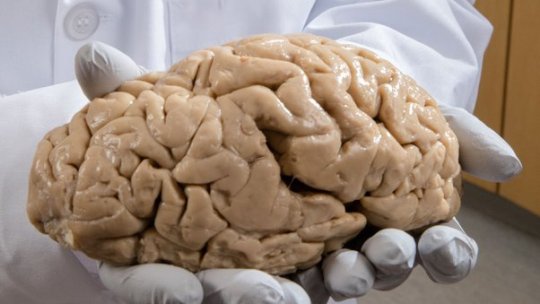
In Sapiens, Professor Yuval Noah Harari explains the reason. It was an evolutionary bargain. The human brain takes up 25% of the body’s energy. Compare that with 8% in other apes, and lesser in other animals.
Unlike today, the primitive Homo Sapiens did not have easy access to high-calorie food. And maintaining such a big brain took a lot of resources and energy. Our ancestors paid for the evolution of a larger brain in two ways — their muscles atrophied and their intestines got shorter.
It was a very heavy toll for the body to spend energy on digesting food, it was a lot more convenient if the food was somehow already broken down or cooked, reducing the amount of energy spent by the body that went into digesting the food.
And the cooked food saved the body vital energy to evolve the larger brain of Homo Sapiens and Neanderthals.
As such, it became difficult to digest more complex food like cellulose.
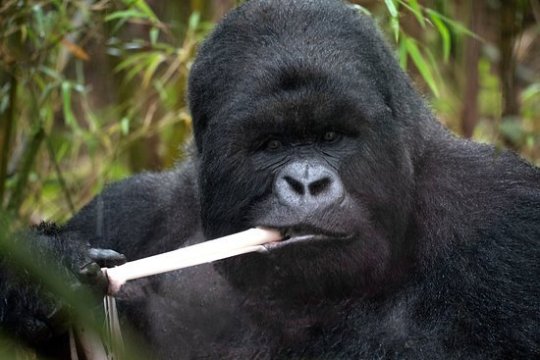
Look at our friend Mr Gorilla here, munching on raw bamboo while none of us can eat sugarcane.
That’s why we cook because we simply can not digest most food in the raw form.
And that’s because we have big brains :)
So, thank evolution that we can choose from a range of tasty stuff to eat. ;)
2K notes
·
View notes
Text
Let's take a closer look at the hominin skulls in the Senckenberg Museum's human evolution room. Keep in mind this is not a linear progression through our ancestors, and more like a bunch of closer and more distant cousins.


The first one, Sahelanthropus tchadensis is seven million years old, and may very well not be a hominin at all. I've always leaned towards the hypothesis that it's a gorilla relative, not one of ours. No matter which branch of the apes it belongs to, it lived not long after the time the human-line (hominins) and the chimp-line separated, and possibly even before that point!


Ardipithecus ramidus, the first hominin from where we can start making a fairly decent family tree of our relatives. Before this point, 5 million years ago, hominin fossils are very rare, fragmentary, and difficult to assign. One of the most interesting things that does seem to emerge from these early fossils is that we have walked on two legs for a long time. Maybe even so long that our common ancestor with the chimps and bonobos did it!

Lucy represents Australopithecus afarensis, who shows up at this point (3.3 million years ago).


Australopithecus africanus, the Taung child to be precise. We're about 2.8 million years ago at this point. Australopithecines must've been such fascinating creatures.
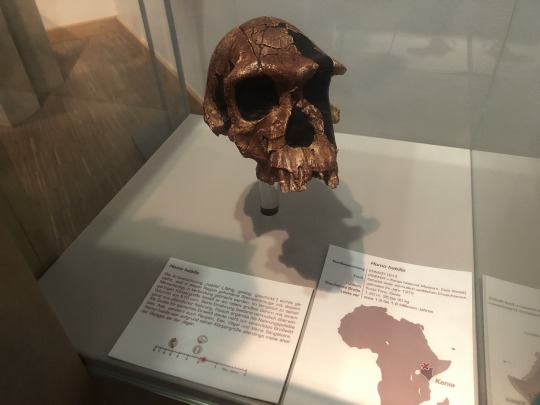

Homo habilis, the 'handy man', named that way because when they were discovered they were thought to be the first humans who used tools. Since then, Australopithecus tools have been found, and tool use by many different animals has also been documented.
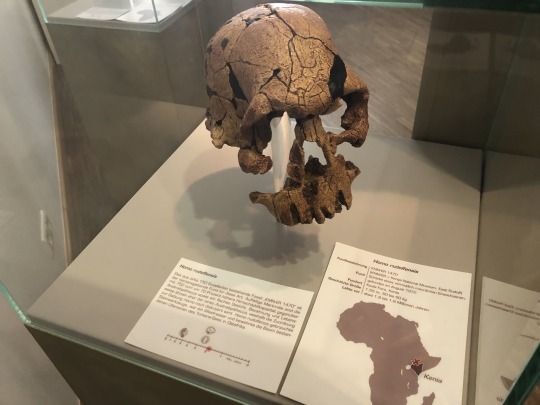

Homo rudolfensis, a population of humans who lived at the same time as Homo habilis and were notably bigger and a little brainier. Does it warrant being its own species? That depends who you ask. Splitting vs lumping is a point of contention in almost every group's biology, and it can run especially high in the field of human evolution since hominins are A very high profile and important fossils that directly relate to our own origins, and B an extremely tangled group that seems to have produced loads and loads of isolated populations and subspecies that regularly migrated all over the place and had frequent interbreeding events. Personally I tend to come down on the side of lumping them into a few major species.


Paranthropus boisei. These were basically a separate lineage of australopithecines, quite different from our own ancestors, who continued to do australopithecus things until quite recently. They were very good climbers and seem to have returned to the trees.

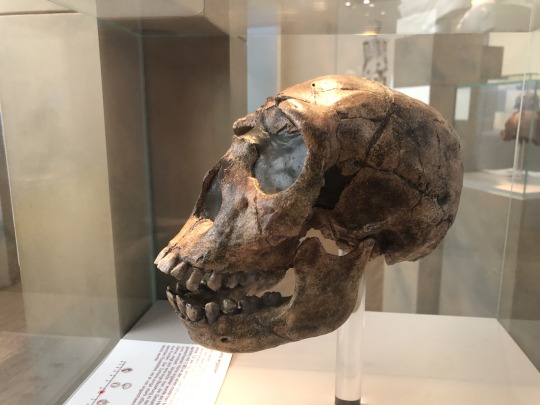
Homo ergaster, either a close relative or a synonym of the more famous Homo erectus. This is the point where we got really brainy, probably figured out how to make fire ourselves, and spread from Africa to Eurasia.

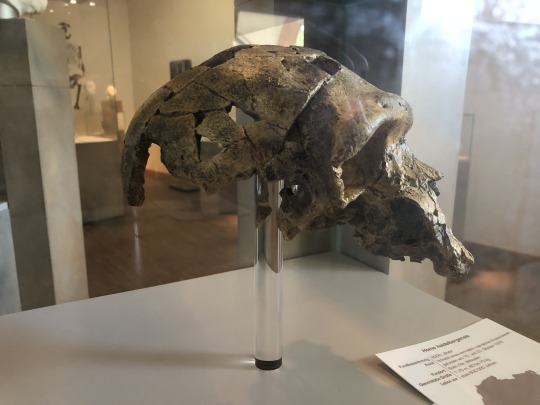
Homo heidelbergensis. Homo erectus and its many subspecies spread all over Africa and Eurasia and existed for well over a million years. As time marches on and evolution did its thing, we eventually start calling the ones in Africa Homo heidelbergensis. They were quite tall, positively enormous compared to little Lucy a few million years back, and they too joined in the human migrations out of Africa. From the H. heidelbergensis who moved into Eurasia we eventually get neanderthals and denisovans, while Homo sapiens evolved from the heidelbergensis populations in Africa.
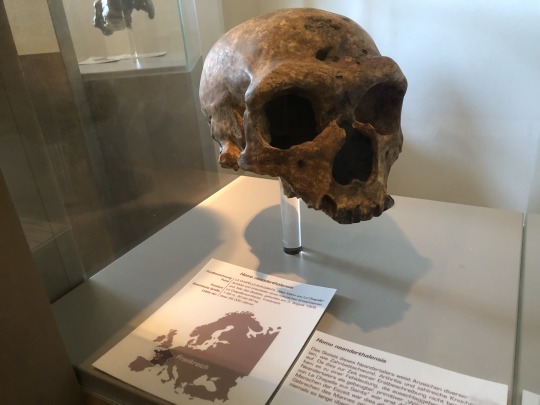

And there's the neanderthals! Large-brained and creative (the first known cave paintings belong to them and they buried their dead), they were likely quite different from the brutish image we often get from them. Rather than truly dying out, their populations eventually merged with the larger Homo sapiens population once they migrated out of Africa, leaving our modern genes with a couple percent neanderthal DNA.
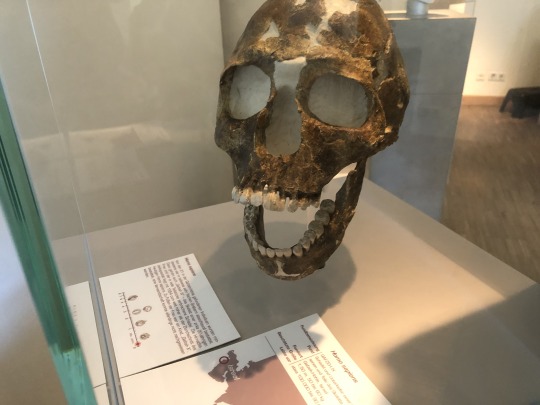
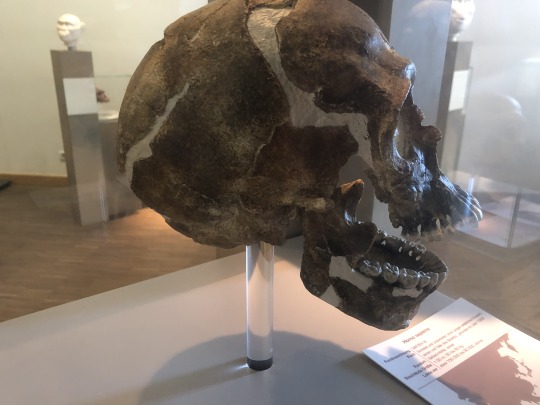
Homo sapiens. And that's us! Not so much the last remaining branch of the human family tree as much as several of the separate branches ended up coming back together and weaving into a single bigger branch.
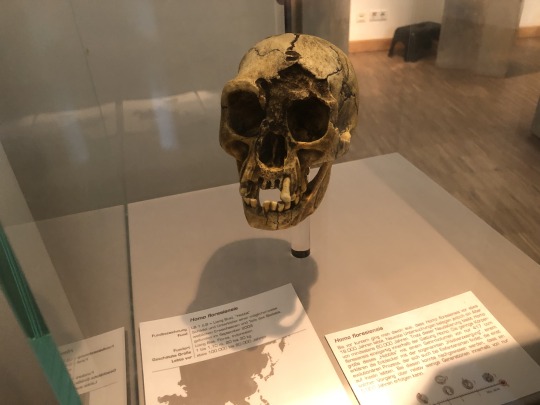

And then there's these little guys, Homo floresiensis! Probably originating from a Homo erectus population that ended up on the island Flores, insular dwarfism ended up making them grow quite tiny. On their isolated island, they remained until about 50000 years ago.
#human evolution#sahelanthropus#ardipithecus#australopithecus#homo#ape#primate#mammal#neogene#quaternary#palaeoblr#senckenberg museum#vicky's vritings
324 notes
·
View notes
Text
If you think there are at least some non-animal organisms, like archaea or fungi or all opisthokonts plants, that meet the stated criteria, select the first option ("Animals or other.") We're discussing terrestrial, biological life only, though, so extraterrestrial life, supernatural beings, or machine intelligences do not figure in to this scheme (but feel free to discuss them in the notes).
Eumetazoa is, AFAICT, the largest group of animals that includes all animals with at least some nervous tissue--so not sea sponges. But it does include a few clades without nervous systems, like the Placozoa.
Chordates are all animals containing a dorsal nerve cord specifically: chordates do not include, e.g., insects, molluscs (including octopuses and squid), and starfish. Chordates do include all fish.
Tetrapods include all animals with four limbs and distinct digits; this excludes most, but not all fish, and includes reptiles, mammals, dinosaurs (including birds), and amphibians.
Mammals includes all animals that nurse their young, have fur, have a neocortex, and have three middle ear bones. This group includes monotremes like the platypus, as well as more familiar animals like dogs, cats, cows, horses, mooses, and more(ses).
Primates includes monkeys, lemurs, apes, tarsiers, lorises and, of course, humans (though all of these clades include humans).
Hominids include gorillas, orangutans, chimpanzees, and humans ("apes").
Hominins includes just humans and chimpanzees (including bonobos). (I think; the taxonomic nomenclature distinguishes between Hominidae, Hominini, Homininae, Hominina, and Hominoidae, so I might have mixed some of these up. Blame the ICZN or whoever is responsible for this mess.)
Australopithecines (equivalent to "Hominina," I think, but don't quote me on that) includes all extinct hominins more closely related to humans than to any other extant species, like Australopithecus africanus, Paranthropus robustus, and of course later species like Neanderthals and Homo sapiens.
Homo is the genus that includes the whole human family in the broad sense: modern humans, Neanderthals, Denisovans, Homo erectus, and Homo habilis.
Homo sapiens includes only anatomically modern humans, as we emerged around 300,000 years ago in Africa.
#i really wanted like four or five more options#to make this poll with sufficient granularity#oh well#pretend eukaryotes bilateria vertebrates and placental mammals are also on the list#and possibly synapsids and the eukaryotes+archaea group just for fun
66 notes
·
View notes
Text
there is a stage in human development starting before our species evolved, when there were several species in existence that we would recognize as human people.
and that period fascinates me.
starting about 2 million years ago, hold on, let me explain, i tend to take the earliest dates possible on things like when we first had fire etc, for two reasons
1
whenever we find ancient evidence of things, we have almost certainly not found anything like the first ever instance of it. In other words, the oldest stone axe we find is never going to be the FIRST stone axe ever made. Which is why
2
every time we have a date on something, it gets pushed. We used to think the “siberian unicorn” (eurasian ice age rhino) went extinct like 200 thousand years ago, and then few years ago we discovered that they survived until at least 40 thousand years ago. So you’re always learning that the earliest use of fire by humans was 200,000 years ago, and then getting announcements like this

And because of this trend in ancient studies, i tend to go with the oldest we think we might have evidence of. Because yeah i’ll bet 1 million years ago is right, hell a few years from now there’s a good chance we’ll find some evidence of human fires from 500 thousand years earlier than that even
All that to say, some of the first people i consider human were probably some subspecies of Homo Erectus

Now about 2 million years ago these folks appear on the scene, but they get more like us by about 1 million years ago, with a brain size average that overlaps ours by then, and use of tools, fire, and probably art (a scientist would say some evidence of POSSIBLY art, as a scientist should, but i personally guess probably yes art for the two reasons listed above). Plus they had a developed language center (the Brocas area in the brain, which leaves an imprint on the inside of the skull) implying a spoken language
And imo, if there’s an upright ape with fire, tools, language and art...

just not our same species of human person.
So at least 1 million years ago, maybe 2 million years ago depending on what early Homo Erectus was getting up to... there were people
and shortly after the 1 million years ago mark, there were a diversification of people splitting off into neanderthal, denisovans, sapiens (us), and several others.
And THAT’s the period of time that fascinates me most
i envision it as a tolkien-esque landscape of dwarf-like giant-like, halfling/gnome-like, troll-like, and elf-like peoples
possibly even some goblin and/or orc species, whether from the ape-ish end of the homo genus, or something just plain ape similar to a baboon or macaque or chimp but ever so slightly more developed and which made an ecological niche for itself raiding the various humanities (sort of in the vein of those chimps that started stealing machetes from people, if they were the same chimps that raid gorilla bands to snatch and eat baby gorillas, with a dash of those macaques and baboons that have basically taken over whole cities in, like, South Africa and India and places)
anyway, thats something i just keep coming back to, it fascinates me so
78 notes
·
View notes
Text

Mʏ Aᴅᴠᴇɴᴛᴜʀᴇs ᴡɪᴛʜ Sᴜᴘᴇʀᴍᴀɴ - Sᴇᴀsᴏɴ 1 Eᴘɪsᴏᴅᴇ 1
A collection of random lines compiled from the first episode of My Adventures with Superman
Feel free to change the pronouns in order to better suit the parts involved.
❝ Pew-pew! ❞
❝ You nervous? ❞
❝ I can do this. ❞
❝ It gets better. ❞
❝ Ha! I am pumped. ❞
❝ Time for Plan B. ❞
❝ Goodbye forever. ❞
❝ This is precious. ❞
❝ Don't touch that. ❞
❝ We have no buyer. ❞
❝ We're stuck here. ❞
❝ It's not gorillas. ❞
❝ How am I doing this? ❞
❝ Oh, that's not good. ❞
❝ What are we going to do? ❞
❝ I've already got a lead. ❞
❝ Hi, there. After... you. ❞
❝ Do what I tell you to do. ❞
❝ Hey, you gotta slow down! ❞
❝ No. ___, you're an intern. ❞
❝ Do not crush his/her hand. ❞
❝ These are the new interns. ❞
❝ She/He's gotta be an alien. ❞
❝ I can't believe we're late. ❞
❝ Okay. I think we lost them. ❞
❝ Come on, ___. We're a team. ❞
❝ We're not a team. ❞
❝ What took you so long, ____? ❞
❝ Oh! I can't believe him/her. ❞
❝ Well, I didn't plan for this. ❞
❝ I know what I'm talking about. ❞
❝ You didn't give us the chance. ❞
❝ ___, this is your last chance. ❞
❝ The crew was getting restless. ❞
❝ People need to know about this. ❞
❝ There's a big pothole up there. ❞
❝ No, don't do that to your boss. ❞
❝ See you in there, big guy/girl. ❞
❝ Wait, were they garbage trucks? ❞
❝ Uh, they came from an army base. ❞
❝ It could be the sewer dinosaurs. ❞
❝ We've hit a snag in the operation. ❞
❝ What we need to do is keep moving. ❞
❝ New interns, out. Old intern, stay. ❞
❝ You didn't give us the chance. ❞
❝ Really? He/she seemed pretty upset. ❞
❝ Nah, that's just his/her face. ❞
❝ Our fence wasn't at the drop point. ❞
❝ Fine. I don't need your help anyway. ❞
❝ And then he says I'm the selfish one. ❞
❝ We call ourselves the Newskid Legion. ❞
❝ Why do you think that keeps happening? ❞
❝ Look around. There has to be something. ❞
❝ They're moving the robots to the docks. ❞
❝ And I saw a weird pigeon. It was gross. ❞
❝ Which one of you messed with the robot? ❞
❝ Do what I say and we can still get paid. ❞
❝ Like the fact that aliens walk among us. ❞
❝ Uh, sorry. I'll fix the front door later! ❞
❝ Ready for me to bust the story wide open? ❞
❝ There's only so many places to hide them. ❞
❝ Then what are we waiting around here for? ❞
❝ We don't even know what half this stuff is. ❞
❝ I got him/her fired from his/her dream job. ❞
❝ I can't believe our alarm clock exploded again. ❞
❝ This isn't about the city, ___ , it's about you. ❞
❝ Uh, wait. ___, this is starting to feel dangerous. ❞
❝ You're, like, twice my size. You can definitely... ❞
❝ We don't have to go through the window, or whisper. ❞
❝ Okay, I had to save the cat. I had to save the cat. ❞
❝ PM could be initials, like...Paranormal Meta-sapiens! ❞
❝ Just take a risk. What's the worst that could happen? ❞
❝ The only reason I called you in today was to meet them. ❞
❝ I'll tell our boss all of this the instant we meet him. ❞
❝ So, I'm, uh, just gonna leave before this gets any worse. ❞
❝ You do not report the news. You do not leave this building. ❞
❝ Uh... Well, it's... Today's my first day of work and I'm... ❞
❝ And with my keen eye for observation, huh, I'll get the proof. ❞
❝ This is it. This is the story that'll make you a real reporter. ❞
❝ I'm a normal man/woman/person having a normal day, starting now. ❞
❝ We're meeting my important and very serious journalistic source. ❞
❝ What is wrong with your dumb, beautiful, coward of a best friend? ❞
❝ Wait, did you say "beautiful"? ❞
❝ It's bad business to hand out freebies. I need something in return. ❞
❝ I mean, yes, I lied.But he/she wouldn't have helped me unless I had. ❞
❝ Aliens, Loch Ness, Bigfoot...that one psychic starfish from Germany. ❞
❝ Your job is to teach the interns how to scan things and make coffee. ❞
❝ For the good of me, you need to stop coming in with these wild ideas. ❞
❝ I trusted you, and you used me and ___ just so you could get your story. ❞
❝ It's the term for the super-intelligent gorillas France has been hiding. ❞
❝ Ooh, and I have the three dozen donutsy ou wanted to eat all ready to go. ❞
❝ We're just two dummies who listened to you because we didn't know any better. ❞
❝ I mean, technically, yes, but you wouldn't have helped me if I told the truth. ❞
❝ Oh, have you considered that these robots might have come from beyond the stars? ❞
❝ I was being selfish, and you just left us. But you came back, and...And I'm sorry. ❞
❝ Why don't we panic real loud in front of the thieves and killers we hired for this job? ❞
❝ Ugh. I know. He/She did lie, but would I have helped him/her if he/she told me the truth? ❞
❝ He/She kept me behind because he/she wants you to help me follow up on my stolen robot story. ❞
❝ Hmm. If I had to transport stolen goods through the city...I'd find a way to do it in plain sight. ❞
❝ And because they see everything during their routes, they always know what's happening in the city. ❞
❝ ____ , we can't just sit in a warehouse full of freaky stolen science weapons till the cops show up. ❞

#my adventures with superman#superman#clark kent#lois lane#jimmy olsen#rp meme#roleplay meme#roleplay ask meme#rp ask meme#ask meme#sentence starters#writing prompts#dialogue promt#original#dc rp#dc comics rp#dc roleplay#dc comics roleplay#dialogue prompt
32 notes
·
View notes
Text
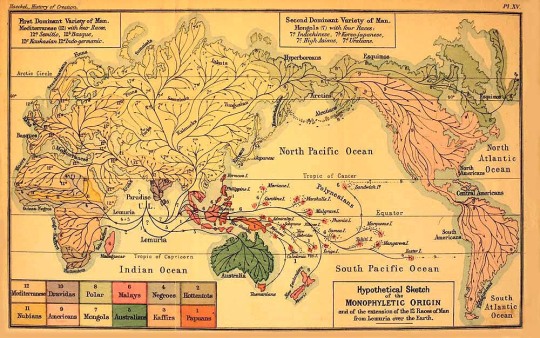
Map of the migrations and "races" of humankind from Ernst Haeckel's History of Creation: Or the Development of the Earth and Its Inhabitants by the Action of Natural Causes, volume II, 1880.
The map is based on a conception of races as relatively static, geographically defined, and branching early in the history of our species. Modern genetics show that the corresponding geographical groups are comparatively recent and form from the fusion of earlier lineages with very different boundaries (for example, most inhabitants of Europe seem to descend from the union of at least four major ancestry groups: the first Homo sapiens or "Cro-Magnon" who came to Europe 40-30,000 years ago; the western half of a Siberian group at the end of the Paleolithic, the eastern half of which went to populate the Americas; a wave of wheat farmers from the Near East; and Proto-Indo-European herders from the Eurasian Steppe).
Another interesting thing is that Haeckel placed the origin of humanity in the Indian Ocean, in the hypothetical sunken continent of Lemuria. (This was before plate tectonics and continental drift were proposed, so distribution patterns of living species were usually explained by having continents rise and sink through time.) There actually was a lively debate at the time about whether Homo sapiens first began in Africa or in tropical Asia. Darwin, for one, placed it in Africa, correctly identifying gorillas and chimpanzees as our closest relatives. Haeckel favored Asia because he saw a greater resemblance with orangutans, and because of the recent discovery of Pithecanthropus erectus (now Homo erectus) in Indonesia.
16 notes
·
View notes
Text
Too many fantasy societies based upon Homo Sapiens. What about the other great apes, huh?
Chimpanzee: Hedonistic id-driven community. Constant power struggles within & without keep leadership structure churning in a way that could be considered stable if you don't think too hard about it. All neighboring clans simultaneously at war & hooking up with each other, relatively chill with outsiders (but watch out!).
Gorilla: Roving polygamous family unit, with moderate rates of exchange between groups. Highly ritualized conflict resolution procedures generally prevent fatal in-group violence, but individuals expelled from the group commonly succumb to the elements or are killed by beasts. Notoriously proud & squadded up, do not smile at them!
Orangutan: Loosely-connected web of hermits. Complex individual relationships make for interesting chance encounters. Conflicts occur over land rights, the winner sometimes undergoing a strange metamorphosis that deepens their territorial and isolationist tendencies. Obviously wizards.
#world building#obviously gorillas are enhanced by swapping the genders this is World Design 101#just take all those boring stock fantasy races you don't care about and make 'em into these#Actually no these are all halflings#new setting just dropped it's all fucked up halflings
17 notes
·
View notes
Text
EDIT: fixed so it’s not a day anymore
followup to my evil primates poll
#caydeposting#tumblr polls#primates#not judging too harshly cos I’m a fan of several on this list#especially gorillas and mandrills
5 notes
·
View notes
Text
oggi alle 19, in rete su meet, il seminario di valentina presti danisi
oggi alle 19, in rete su meet, il seminario di valentina presti danisi

View On WordPress
0 notes
Text
It's lonely on Earth without Neanderthals and Denisovans.
We need that elven friend who is similar to us but different. We need that pal who has a new perspective to share that helps us see outside ourselves. A quiet, thoughtful, observant friend who doesn't say much but understands more about the world than we do. A nearly celibate companion who will only procreate once in their lifetime, if they even procreate at all.
I think we made a mistake by out-populating and absorbing them so thoroughly into humanity. It's been 40,000 years without them. In that time without them, homo sapiens have gotten lonely and strange. We're missing our elves!
This is why we teach sign language to chimpanzees and gorillas. This is why we domesticate animals. This is why we project hominid intelligence onto all other species.
We're searching for that connection we lost. We're looking for elves.
20 notes
·
View notes
Text
I think one major potential weakness of the bonobo-like human social system is it might be less effective at preventing inbreeding.
A major Homo sapiens inbreeding-avoidance strategy is communities exchanging people through marriage. Historically, this was often gender-asymmetric, with women being exchanged more than men. I suspect this gender-asymmetrical exogamy pattern was a major contributor to the development of patriarchy; it meant women got their social connections disrupted more. One of my major worldbuilding challenges for bonobo-like humans is giving them features that would either prevent this gender-asymmetric exogamy pattern from emerging, mitigate its disruptive effects on female-female and male-female solidarity, or some combination of both.
@who-canceled-roger-rabbit some of this is kind of relevant re: that conversation we had a while back about matriarchies.
I suspect the causes of this gender-asymmetry in Homo sapiens exogamy are 1) male solidarity was more important to military power, 2) the last common ancestor of gorillas, chimps, and humans had silverback-centered social groups in which a single dominant male was the nucleus of the group and chimps and humans inherited a tendency toward females changing social groups at maturity from them. I'm not really worried about 2), human behavior is pretty flexible, but 1) seems like a probable huge obstacle to the emergence of a female-privilege society (which I suspect is a big part of the reason unambiguously female-privilege societies were rare to nonexistent in Earth history if the known historical record is anything to go by).
IIRC actual bonobos seem to have kept the social pattern inherited through 2) and went the mitigation route; female bonobos change social groups more than male bonobos, and the key to female power in bonobo society is strong solidarity between non-kin females reinforced through sexual bonding. It would be intensely on-brand if bonobo-like human women also use sexual bonding between women to build strong female solidarity between unrelated women and thus mitigate the disruptive effects of females changing communities as an inbreeding-avoidance strategy.
I don't think I'll make that the whole picture with them though, because my ideas on how they got a low-key female privilege society hinge on matrilineal kinship solidarity between mothers and their adult children being important. Importantly, that model would make matrilineal kinship solidarity between women and matrilineal kinship solidarity between women and males both important for maintaining the bonobo-like human social order, which would tend to discourage exogamy of any kind.
Regarding the second thing, I think one big leg-up bonobo-like human women might have over bonobo females there is being smarter. Bonobo-like women are smart and (through language) communicative enough to observe the deleterious effects of inbreeding, realize they are consequences of mating with relatives, and do deliberate and coordinated inbreeding-avoidance. I suspect actual bonobos do inbreeding-avoidance behaviors without realizing that's what they're doing, in an "adaptation executor, not fitness maximizer" way. Deliberate planning is much more flexible and optimizable than "adaptation executor, not fitness maximizer" behavior. A bonobo-like woman can conceptualize the social benefits of remaining in her natal social group while also conceptualizing the risks of mating with close relatives and then imagine a strategy for exploiting her capacity to track her menstruation/ovulation cycle to simultaneously have the former and avoid the latter; wait until she's near ovulation, then travel to another group and submit to a consensual gang-bang, then travel back to her natal group and rejoin them. That sort of "having their cake and eating it too" reproductive strategy would have big potential social benefits for women compared to changing groups, so once they got the idea I expect it'd become very popular - and older bonobo-like women would start encouraging their daughters and nieces to plan their futures around following it, so their daughters and nieces would stay in their natal group and keep contributing labor to their natal group.
Also, re: bonobo-like strategy of using sexual bonding to recruit unrelated women into strong female solidarity networks...
... An idea I like is bonobo-like women eventually got good enough at that to turn that strategy on males and assimilate outsider males into female-centered solidarity networks in the same way. Basically, male kinship solidarity was less important to the military power of small communities in bonobo-like humans because in their species the community's women could totally take some wandering mercenary, go to work on him, and turn him into a fiercely loyal ride-or-die human guard dog for their community in a few years. Actually, when I put it that way, I suspect Homo sapiens women have a social strategy like this too and it's part of what went into the knight/damsel thing and this and that whole women as civilizers/domesticators of dangerous wild men concept (Enkidu and Shamhat might be allegorically about this!) and a nontrivial amount of male misogyny is rooted in the fear that a woman might rewire your brain in ways your present self wouldn't like by doing this to you. But I guess the bonobo-like human version would be more powerful (when used on bonobo-like human males, at least) and less monogamish (sapiens versions of this kind of male domestication narrative seem to heavily emphasize couples, but that might be culture-specific). Ability to do that might have made ancient bonobo-like human communities much more gender-balanced in terms of bringing in new genes by assimilating outsider women vs. bringing in new genes by assimilating outsider males.
A lot of this wouldn't be directly relevant to bonobo-like human society today, when it's pretty peaceful, but bonobo-like human typical neurotype and culture would be influenced by the social conditions and physical conditions their ancestors lived in, just like our typical neurotype and culture are influenced by the social conditions and physical conditions our ancestors lived in.
Also, I like the idea that bonobo-like humans are a more genetically diverse species than us because they missed Toba and maybe a few other genetic bottlenecks that badly depleted our genetic diversity, so inbreeding would be less damaging to them. So that might help.
#bonobo-like humans#gender#my big ideas#for the “I suspect Homo sapiens women have a social strategy like this too” part
6 notes
·
View notes
Text
Garten Of Banban: As Above So Below - Primary Genome For Mascots
So uhh, I decided I’d share what animals the Mascots are meant to primarily pull from in my GoBB rewrite, just to give y’all a better idea for what they are gonna be looking and behaving like. So let’s gooo~!
NOTE: ALL SUBJECTS HAVE HOMO SAPIEN (HUMAN) ALONGSIDE THEIR OTHER PRIMARY DNA SOURCE
Banban - Capra Hircus (Domestic Goat)
Banbaleena - Ovis Aries (Domestic Sheep)
Jumbo Josh - Gorilla Beringei Graueri (Eastern Lowland Gorilla)
Captain Fiddles - Brachyteles Hypoxanthus (Woolly Spider Monkey)
Opila Bird - Phoenicopterus Roseus (Greater Flamingo)
Tarta Bird - Pavo Cristatus (Indian Peafowl)
Stinger Flynn - Chrysaora Quinquecirrha (Atlantic Sea Nettle)
Slow Seline - Cornu Aspersum (Garden Snail)
Sheriff Toadster - Bufo Bufo (Common Toad)
Nabnab - Cyriopagopus Lividus (Cobalt Blue Tarantula)
Nabnaleena - Heterometrus Longimanus (Black Scorpion)
Queen Bouncelia - Macropus Giganteus (Eastern Grey Kangaroo)
Bittergiggle - Ectophylla Alba (Honduran White Bat)
Tamataki + Chamataki - Chelonoidis Niger + Trioceros Jacksonii (Galápagos Tortoise + Jackson’s Chameleon)
Syringeon - Dynastes Hercules (Hercules Beetle)
Kittysaurus - Smilodon (Saber-Toothed Tiger)
Zolphius - Biston Betularia (Peppered Moth)
#gobb#garten of banban#garten of banban rewrite#gobb: as above so below#banban#banbaleena#jumbo josh#captain fiddles#opila bird#tarta bird#stinger flynn#slow seline#sheriff toadster#nabnab#nabnaleena#queen bouncelia#bittergiggle#tamataki and chamataki#syringeon#kittysaurus#zolphius
18 notes
·
View notes
Text
Моя индивидуальной проект в колледже:3
Каннибазм в человеческом обществе
Каннибализм - насколько люди заинтересованы в этом явлении? Сколько представителей можно назвать? Скорей всего в голову всем придет несколько образов: изысканный и умный Ганнибал, то из людей готовит сладостные блюда, или же бессмертных не приятных на внешних каннибалов из «поворота не туда», или же полуголых папуасов, что живут на необитаемом острове и едят всех названных гостей? В чем мотив этих людей, что заставило их съесть себе подобное существо? Можно ли предотвратить это?
В этом индивидуальном проекте мы рассмотрим разные ситуации, где люди были либо вынуждены съесть себе подобных либо по собственному желанию прибегли к каннибазму.
Давая определения каннибализму люди пришли к такому выводу и классификациям:
Каннибализм-это внутривидовое хищничество, поедание представителей собственного вида.
Автоканнибализм- (Корень «авто» происходит от древнегреческого слова «αὐτός» (аутос), что означает «сам» или «самостоятельный».) поедание самого себя. Например,: собственное мясо, ногти, перхоть, волосы, свои отходы.
Экзоканибаллизм- (от греческого exo- «извне» и каннибализм «поедать людей»), в отличие от эндоканнибализма , — это поедание плоти людей, не принадлежащих к близкой социальной группе, например, поедание своих врагов. Это интерпретировалось как попытка приобрести желаемые качества жертвы и как «высшая форма унижения и доминирования» побежденного врага в войне.
Эндоканнибализм- (эндо – от др.-греч. ἔνδον — «внутри» и каннибализм «поедать людей») это практика каннибализма в собственной местности или сообществе. В большинстве случаев это относится к употреблению в пищу останков умершего в морге.
Цель моего проекта выяснить причины возникновения каннибализма.
Задачи изучить теоретический материал и скомпоновать в этом проекте. Создать физические модели и цифровые. И защитить проект.
Теория
Глава.1.1 Появления
Сначала рассмотрим времена, когда наши предки были больше похожи на обезьян чем на людей. Когда они решили прибегнуть к съедению представителя своего вида. Наиболее древняя находка, свидетельствующая о каннибализме у предков Homo, датируется около 1,5 млн лет назад .На проксимальной части большой берцовой кости KNM-ER 741 гоминина неизвестного вида из кенийского местонахождения Кооби-Фора возрастом около 1,45 млн лет, найдено 9 следов от каменных орудий и два от зубов крупного представителя семейства кошачьих.(Гоминин этоподсемейство семейства гоминид (Hominidae), к которому относят человека разумного (Homo sapiens), шимпанзе (Pan), горилл (Gorilla), а также ряд вымерших групп.)
Однако с какой целью разделали владельца KNM-ER 741 — с целью съесть, или же это была некая культурная традиция? Предыдущие исследователи выделяли самые разные мотивы и контексты человеческого ка��нибализма, от поедания сородича с целью выживания до употребления частей его тела в пищу в медицинских или духовных целях, при этом в пищу могли пойти не только чужаки, но и представители собственной семейной группы каннибала.
Учитывая отсутствие свидетельств первичного или вторичного захоронения, или других ритуальных действий в раннем плейстоцене, авторы работы полагают, что следы на кости KNM-ER 741 — пример пищевого каннибализма, так и систематическим. Судя по особенностям разделки гомина разделывали там, где было мясо.
Глава.1.2Причины
Основные причины каннибализма в прошлом были такие: Голод, Запугивание, Конфликты.
Но с эволюцией и развития общества их стало больше: девиации, теофагия, «лечение», любопытство, уважение, не знание,религия,устрашения.
Глава.1.3Голод в Поволжье
Продолжая темы причин, мы снова затронем извечную причину каннибализма голод.
Голод в Поволжье прекрасный пример вынужденного каннибализма. Причиной голода стало: продразвёрстка, засуха, гражданская война. В то время люди были вынуждены есть, что попало от домашнего скота до человека. Многие люди пытались покинуть свои родные кроя, они были готовы бросить своего ребенка лишь бы выжить и не умереть голодной смертью некоторые дети тоже уходили.
Все началось в 1921 и закончилось в 1923.Согласно данным официальной статистики, голод охватил 35 губерний, сильно пострадали-Самарская, Саратовская губернии, Южная Украина, Крым, Башкирия, Казахстан, частично Приуралье и Западная Сибирь. В то время погибло много людей от голода, болезней. В то время страна потеряла 5 млн человек из-за голода в Поволжье. Гуманитарной помощью занимались Американцы и Советская власть.
Глава.1.4. Случайность.
Продолжим рассмотрение причин следующая: случайности.
Это было в Казахстане в Алма-Ате в 1998 году стали исчезать проститутки. В январе 1999 года в мусорных контейнерах нашли расчленённые останки одной из девушек, которая числилась без вести пропавшей. После этого части тел стали находить в разных районах города. Троица людоедов из Капшагая называла себя «санитарами кварталов красных фонарей». Бывший полицейский Сергей Копай, его сводный брат Евгений Турочкин и фельдшер Михаил Вершинин убили и съели девять женщин. Но также эти «гинекологи» продавали фарш из проституток обычным людям. Из-за этого в Казахстане, кто-то по случайности и не знанию попробовал человеческое мясо, думая, что это обычный фарш животного.
• Глава.1.5. Осада Суйяна
Осада города Суйяна прекрасный пример каннибализма, причиной которого стал конфликт и война.
Осада города Суйяна это военная кампания во время восстания Ань Лушаня, начатая повстанческой армией Янь с целью захвата города Суйян у лоялистских сил танской армии. Хотя битва в конечном счете была выиграна армией Янь, она понесла большие потери в живой силе и времени.25 января – 9 октября 757 г.
(8 месяцев и 2 недели).
Когда у жителей осажденного города закончились припасы, они начали есть сначала лошадей, а затем «стариков, детей и женщин». В своих биографиях Чжан Сюня, Старой и Новой Книге Династии Тан (закончены между 945 и 1060 годами) – основных официальных династических историях, охватывающих период Тан, – подсчитано, что около половины первоначального населения в 60 000 человек (включая войска) были съедены. Когда город окончательно пал, «в живых осталось всего 400 человек» – менее одного процента от первоначального населения. Согласно Старой книге династии Тан, Чжан Сюнь убил свою собственную наложницу в качестве еды для голодных солдат, чтобы убедить их, что такие экстремальные жертвы того стоили.Сюнь привел свою наложницу, убил ее на глазах у армии и представил солдатам, сказав:
«Братья, ради своей страны вы общими усилиями защитили этот город…. Я не могу нарезать себе мясо, чтобы накормить вас, но как я могу пожалеть эту женщину и просто сидеть в стороне и наблюдать за опасностями?» По их лицам катились слезы, солдаты не могли есть. Сюнь силой приказал им съесть ее.
В то время была жёсткая иерархия сначала убивали женщин потом стариков и маленькие мальчики. Взрослые и дееспособные мужчины ценились больше всего, так как они могли воевать.
1.6 убийцы каннибалы
Теперь рассмотрим убийц каннибалов.
Начнем с маньяка из нашей страны:
Александр Николаевич Спесивцев-«маменькин маньяк», «Новокузнецкого монстра». Убивал,насиловал,глумился над телами своих жертв и все это он делал в своей квартире где жил с матерью, что была не против его отвратительного хобби, она ему даже помогала искала жертв приводила к ним домой.
На счету этого аморального человека официально 5 человек, но скорее всего жертв было гораздо больше в СМИ считали, что он жертв 82. Действовал он с мая по июнь 1991 года и с февраля по октябрь 1996. Его мать готовила из жертв супы. И Спесивцев скармливал это своим пленникам. Но семья отрицала, что сам он ел человечину, но следствие считало, что ел.
Поймали Спесивцего случайно, тогда в их дом пришли газовщики. Он как обычно не открывал дверь, и Газовщики вызвали участкового, который вскрыл квартиру и увидел множество останков трупов и полуживую Ольгу. Спесивцев сбежал через окно: по пожарной лестнице выбрался на крышу и избежал задержания. Но через два дня был пойман — он вернулся к своему дому, где его ждали сейчас он на принудительное лечение. Родился 1970 в Новокузнецке отец пил и изменял его матери развелись они только когда «Каннибалу Сашке» исполнилось 15.
В детстве он был хулиганом и «маменьки сынком», в школе ни с кем особо не общался был троечником к учебе интерес не имел,но имел интерес к фотографиям ,что приносила мать с работы. Она была помощником адвоката и приносила фотографии трупов, где дома с сыном рассматривала их часами. Воровал в школе. В армию Спесивцев не пошел ,его отправили в психбольницу Новокузнецка на лечении.
Дальше будет Американский серийный убийца Га́мильтон Го́вард «Альберт» Фиш педофил, садомазохист,каннибал и сексуальный извращенец.
«Бугимен»,» Серый призрак», «лунный маньяк»,» Вервольф Вистерии»«Бруклинский Вампир».Родился серийный убийца 19 мая 1870 года при рождении имел имя Гамильтон. Был 4 ребенком в семье и самым младшим. В детстве его отдали в приют, где над ним издевались из-за имени и называли «Яичница с ветчиной» («Ham and Eggs»). Был фетишистом в 1890 посещал Нью-Йорк для занятия проституцией по его признанию насиловал маленьких мальчиков. Даже после женитьбы продолжал это делать. У него родилось 6 детей. В 1903 впервые попал в тюрьму за кражу. Первое убийство он совершил в свой 40 юбилей он убил маленького мальчика, потом заколол умственно неполноценного мальчика. Маньяк говорил ,что убил 500 детей. Официально смогли подтвердить только 3 подозревали в 3-15+. Стоит отметить одну важную вещь, он писал про свои преступления семьям жертвы или звонил .
Так же Фиш писал письма где признавался в Каннибазме и убийствах детей.
Альберта Гамильтона Фиша судили за предумышленное убийство Грейс Бадд. Суд начался в понедельник 11 марта 1935 в Уайт-Плэйнс, Нью-Йорк. Состав суда: судья Фредерик П. Клоуз, защитник Джеймс Демпси, и главный помощник окружного прокурора, Элберт Ф. Галлахер в роли обвинителя. Судебный процесс длился 10 дней. Фиш ссылался на психическое заболевание и заявлял, что он слышал голос, который считал голосом Бога, и этот голос убеждал его убивать детей. Несколько психологов изучали сексуальные фетиши Фиша, включая каприфолию, урофилию, педофилию и мазохизм, однако между ними не было достигнуто согласия в вопросе «Безумен ли Фиш?». Главный эксперт защиты психиатр Фредрик Вертхам, специализировавшийся на детском развитии и проводивший обследования в уголовных судах Нью-Йорка, заявлял, что Фиш безумен. Другим свидетелем защиты являлась Мэри Николас, семнадцатилетняя падчерица подсудимого. Она описывала, как Фиш учил её братьев и сестёр и её саму некой игре, включавшей различные виды садомазохизма и приставаний к детям. Суд посчитал Фиша виновным в убийстве и вменяемым, судья приговорил его к смертной казни на электрическом стуле. После оглашения приговора Фиш сознался в убийстве ещё одного ребёнка — восьмилетнего Фрэнсиса Х.
В марте 1935 Альберт Гамильтон Фиш был переведён в камеру смертников тюрьмы Синг-Синг. Он заявил, что казнь при помощи электричества станет высшим.
Колебанием в его жизни. 16 января 1936 он был казнён на электрическом стуле: в 23:06 он вошёл в помещение для проведения казней, тремя минутами позже было объявлено о его смерти.
Следующим любителем человечины стал житель страны восходящего солнца Сагава Иссей.
Иссэй Сагава родился 26 апреля 1949 года в Кобе в богатой и известной семье. Отец, Акира Сагава, был президентом компании Kurita Water Industries, дед был редактором крупной газеты «Асахи симбун». Ребёнок появился на свет недоношенным, прошёл курс лечения от энтерита. По натуре будучи интровертом, имея весьма хрупкое здоровье, юный Иссэй увлёкся чтением. По собственным словам, первые каннибалистические наклонности проявил в первом классе при виде оголённого женского бедра. Подобную заинтересованность мальчик проявлял и к женщинам. В детстве имел секс с собственной собакой. По окончании школы поступил в частный университет Вако в Токио, где изучал литературу. В 24-летнем возрасте был арестован полицией по обвинению в покушении на изнасилование гражданки Германии. Сагава, который забрался в квартиру девушки, пока та спала, хотел отрезать от её ягодиц кусочек плоти, однако жертва проснулась и оказала сопротивление Сагаве. При аресте он не признался в своих истинных намерениях. После выплаты компенсации отцом Иссэя С девушка забрала заявление из полиции.В 1977 году Сагава поступил в аспирантуру в университет Сорбонна в Париже. Как позже признается сам Иссэй Сагава, каждую ночь он мечтал о том, чтобы привести домой представительницу древней профессии и застрелить её, однако для этого ему не хватало смелости.11 июня 1981 года Сагава пригласил свою голландскую одногруппницу. Рене Хартевелт.Прибыв на квартиру, девушка села за стол и начала изучать стихотворения, после чего Сагава отошёл ей за спину и выстрелил в шею из малокалиберной винтовки. На некоторое время потеряв сознание от шока, вызванного содеянным, он изнасиловал труп Рене. Безуспешно попытавшись прокусить кожу, Сагава вышел из квартиры и приобрёл тесак, с помощью которого разделал тело жертвы. Он употребил в пищу различные части тела девушки, в основном груди и лицо, подробно фотографируя каждый этап процесса. По его описанию, мясо было «мягким» и «без запаха», как тунец. Плоть Сагава ел как сырой, так и приготовленной. Часть останков Рене он убрал в холодильник, а часть упаковал в два чемодана и попытался выкинуть их в озеро в Булонском лесу, где и был схвачен французской полицией. Получив известие об аресте сына, Акира Сагава перенёс удар, однако вновь пришёл на выручку Иссэю, наняв для него адвоката. После двух лет содержания под стражей бывший студент был признан невменяемым и отправлен на принудительное лечение судьёй Жаном-Луи Брюге. В психиатрическом госпитале Сагаву навестил японский писатель Инухико Ёмота, который на основе взятых с ним интервью опубликовал в Японии книгу об убийстве. Дело Сагавы начало приобретать скандальную известность на его родине, в связи с чем правительство Франции приняло решение депортировать его. По прибытии Сагаву поместили в токийский госпиталь Мацузава, где после обследования медицинской комиссией он был признан вменяемым. Поскольку обвинений против Сагавы во Франции предъявлено не было, а документы по делу не были переданы японским властям, он мог легально находиться на свободе.12 августа 1986 года Иссэй Сагава покинул больницу в Токио. После своего освобождения Сагава поселился в Токио. Интерес к его персоне не угасал более 10 лет. Он часто приглашался на телевидение в роли эксперта, писал колонки в газету, работал ресторанным критиком.
Об убийстве Рене Хартевелт Сагава написал несколько книг, а в 1997 году опубликовал книгу «Мальчик А» (少年A).Иссэй Сагава признавался, что и после убийства его продолжали одолевать людоедские фантазии, но утверждал, что никогда не желал снова воплотить их в жизнь. В 2011 году признавался, что известность его сильно тяготит, называл её «ужасным наказанием».
В последние годы врачи запретили Сагаве есть мясо по причине диабета, из-за которого он почти потерял зрение. В 2013 году перенёс инсульт, после чего за ним ухаживал его брат.
Умер 24 ноября 2022 года от пневмонии в возрасте 73 лет. Про его преступления есть манга, которую он сам нарисовал,
1.7теофагия
Боегоедство или теофагия ещё одна причина каннибализма.
Причащение «телом» человекоподобного бога чаще всего совершалось в виде поедания изображения этого бога, сделанного из теста, или самого того человека, в которого будто бы воплотился бог. Такое причащение, например, существовало в древней Мексике. У ацтеков ежегодно избирался красивый юноша, не имевший физических недостатков, в качестве воплощения бога Тескатлипока, c ним обращались как с божеством, удовлетворяя его желания. По прошествии года жрец закалывал юношу, разрезал его тело на куски и раздавал для поедания участникам таинства.
В некоторых культурах съедание «тела» бога заменялось съеданием посвященного ему животного или хлеба, которому придавалась иногда человекообразная форма. Например: праздничный пасхальный кулич и разукрашенные яйца(фаллос), блины(солнце) и ТД.
1.8устрашения
Люди готовы на многое, чтобы заставить своих врагов бояться, даже на каннибализм.
В 2013 году в интернете появился видеоролик, где сирийский боевик съел сердце убитого врага, все он это снимал на камеру. На ближневосточных интернет-порталах каннибала уже идентифицировали, а некоторые представители сирийской оппозиции даже пообещали его наказать, что, впрочем, маловероятно. Страна стремительно распадается на территории, неподконтрольные ни законным властям, ни противникам президента Асада, и власть там принадлежит как раз таким боевикам-людоедам. Человек совершает военное преступление перед камерой. Клип в 2013 назвали самым отвратительным видео сирийской войны. Полевой командир потрошит убитого солдата — вырезает ножом его сердце, потом легкое, кричит, что так будет с каждым солдатом правительства, и впивается в сердце зубами. За кадром соратники кричат «Аллах велик!» Оператор отпускает шуточки. Видео выложили в Интернет сторонники сирийского режима. В комментариях — фразы наподобие «Вот какую свободу нам хотят навязать» и «Вот кого поддерживают Америка и Израиль». Запись — настоящая. Людоед — Халид аль-Хамад по прозвищу Абу Саккар, основатель повстанческой «Бригады» Умара Фаруха. Это подтвердили репортеры американского журнала The Time.
1.9Повар асексуал
Следующий причиной может стать любопытство, люди склонны к этому им всем интересно запретное.
Сугияма сначала хотел съесть гениталии сам, но вместо этого решил сделать, как он сказал, артистическое заявление. По собственному описанию, будучи асексуальным, Сугияма полагал, что ему не нужны органы, чтобы выполнять свою работу.Сугияма сказал, что отправился в одномесячный сексуальный загул перед операцией, чтобы удостовериться, что он не будет сожалеть о своих причиндалах, но проверился после этого и не обнаружил никаких венерических заболеваний. Однако гости должны были подписать отказ, что он не несёт ответственности в случае, если они заболеют от его «еды». Приблизительно 70 человек собрались на банкете, который проводили в зале Suginami в Токио. Сугияма, нарядившись в костюм шеф-повара, сам потушил свои гениталии на портативной газовой горелке. Пять посетителей заплатили по $250 за тарелку «особенной» еды, пока другие посетители ели мясо крокодила и говядину. Пять человек, которые обменяли деньги на гениталии, включали любопытную пару, мужчину – художника манги, 22-летнюю женщину и организатора вечеринок. Всем было от 22 до 32.К сожалению, для посетителей, еда не привела в восторг – член описали как нечто `эластичное с мягким вкусом.
Когда директор кулинарного сайта Serious Eats Дж. Кенджи Лопес-Алта прочитала об отсутствии удовлетворения от такой пищи, она заявила: «Шеф-повар приготовил блюдо неправильно. Какая бессмысленная трата хорошего члена! Член довольно жёсткий и должен готовиться медленно, например, его можно потушить». После этого на Сугияму подали в суд,но не про каннибализм (в Японии он не запрещен). Его обвинили в непристойном обнажении.
Сугияма сказал, что обвинение в непристойном обнажении было неуместным, так как все приглашённые знали точно, в чём заключалось событие.
Сугияма также удостоверился, что не нарушил никаких законов, включая запрет на продажу органов, соблюдение санитарных норм в отношении отходов и еды. Он утверждал, что событие было мастерски мотивировано и разработано, чтобы повысить осведомлённость о «сексуальных меньшинствах, x-поле, асексуальных людях».
Обвинения были сняты в феврале 2013 года.
2.0 мумии
В наши дни мумии из Египта — дорогие и уникальные музейные экспонаты. Ценились они и в средневековой Европе. Но вовсе не как культурно-историческое наследие. Цель была сугубо практическая.
«Мумия обыкновенная» и «особая из гробниц», «измельченная» и «порезанная на куски» — такие снадобья веками продавались в аптеках. На протяжении почти семисот лет и простолюдины, и короли применяли весьма нестандартное лекарство. Что только не лечили — от головных болей до чумы.
Эти рецепты пришли с Востока.
К XVI веку сформировался настоящий рынок покойников. Предложение не поспевало за спросом. Развернулась подпольная индустрия. Предприимчивые дельцы быстро нашли альтернативы.
«Торговцы иногда выдают поджаренное верблюжье мясо за мумифицированное человеческое», — писал португальский аптекарь Томе Пирес.
А врач короля Наварры Ги де Лафонтена вспоминал, как в 1564-м разговорился с одним купцом из Александрии. Тот признался, что собственноручно готовит «целебное средство из тел недавно казненных преступников».
Усомнились в этой «панацее» лишь на рубеже XVII-XVIII веков.
Но почему они вообще начали использовать мумии, как панацею? в XI веке к ученым из Университета Салерно (Италия) попал трактат известного арабского медика Ибн Сины (более известного как Авиценна). Там описывался препарат для лечения целого ряда недугов — тошноты, ушибов, переломов, язв и абсцессов тканей. Назывался «мумией». Однако врачеватель не разъяснил происхождение лекарства.
На Востоке прекрасно знали, что «мумия» — это природный битум. «Мум» по-арабски — «воск», «смола». Добывали главным образом в Мертвом море. Европейцы же были не в курсе дела. Но знакомое слово вызвало интерес. И переводчики из Салерно добавили в трактат комментарий.
«Мумия представляет собой субстанцию, которую можно отыскать в тех краях, где хоронят забальзамированные с алоэ тела», — писал итальянский ученый XII века Герард Кремонский. Его коллеги позднее домыслили, как именно образуется чудодейственное средство. По их мнению, сок алоэ, смешиваясь с жидкостями из тела, со временем превращался в ту самую «целебную мумию».
2.1Ритуал Яномами
Эндоканнибалзм.обычно распространён как ритуал связанный с прощением умершего, в закрытых племенах. Для этих закрытых племён это не зверство, а проявления уважения к умершему.
Племена Яномами очень трепетно относятся к древним традициям и по сей день их соблюдают. Одной из самых ярких является их погребальный ритуал. После смерти человека, члены племени впадают в гнев. Их гнев направлен на духа забравшего жизнь их соплеменника. Яномамо украшают свои лица чёрной краской и крадут горсточку жевательного табака в рот умершего. После, люди начинают петь, взывая душу умершего вернуться в тело. Этого конечно же не происходит и тогда умершего начинают оплакивать. После того, как соблюдены все правила, тело сжигают, а кости, оставшиеся в костре, перемалывают в муку.
Костяную муку смешивают с платанами полученную кашу едят все члены племени. Яномамо верят, что только это может успокоить душу и позволит ей уйти в загробный мир. Несмотря на тот факт, что они употребляют в пищу прах родственников, поедания мяса с кровью, даже мясо животных – неприемлемо для Яномамо.
2.2Последствия
В большинстве стран человека ждёт уголовная ответственность кроме: Японии, Америке, в некоторых странах ЮАР, Индия, Фиджи,Бразилия,Камбоджа. Например, если взять Россию в ней
Каннибализм является преступлением по законодательству и запрещен в любой форме, как бы он ни был осуществлен. Конкретно ситуация, которую вы описываете, является не только противоестественной, но и преступной. В соответствии со статьей 105 Уголовного кодекса РФ, убийство с последующим использованием тела убитого в целях каннибализма приравнивается к особо тяжкому преступлению и наказывается до пожизненного лишения свободы.
Так же поедание не приготовленных мозгов людей может вызвать болезнь Куру. Болезнь Куру или смеющаяся болезнь это Редкое неизлечимое смертельное нейродегенеративное прионное заболевание, встречающееся в высокогорных районах Новой Гвинеи у аборигенов племени форе. Представляет собой форму трансмиссивной губчатой энцефалопатии, вызванную передачей аномально свернутых белков, что приводит к таким симптомам, как тремор и потеря координации из-за нейродегенерации.
2.3. способы деромантизации
1. Фильмы, книги где каннибализм выставляют с плохой стороны.
2. Рассказывать какие последствия будут потом со стороны закона.
3. Рассказать о болезнях, что могут быть.
2.4. заключения
Из моего проекта я поняла, что каннибалам может стать любой человек, что сильно хочет жить. Так же Я осознала, что романтизация каннибалов в фильмах, играх, сериалах, аниме это не очень хорошо. Я считаю, что к людоедству нужно прибегать, только в тех ситуациях, когда от этого зависит жизнь человека, так же я считаю, что нельзя убивать человека (можно подождать). Так же я считаю, что молодым людям нужно перестать романтизировать каннибалов. И вообще не заглядывать на сайт «cannibal cafe» . Это не приятный сайт, где каннибализм — это фетиш и на продажу есть так называемые «cow girl», там женщины (мужчин я не видела) описываются, как животные и секс игрушки. По моему мнению такое уже надо лечить если ты хочешь съесть себе подобного или, чтобы тебе съели в обычной жизни. Таким людям нужна помощь профессионалов, им нужно лечиться. Но в то же время у меня есть противоречия насчёт некоторых героев, например, Ганнибал, это действительно харизматичный персонаж. Но романтизация его каннибала отвратительна и то, что он убийца, но опять же людей привлекают антигерои и злодеи.
Вывод единственный случай когда каннибализм не будет особо осуждаем это катастрофический когда люди вынуждены съесть уже тела мертвых людей.
Источники:
B. Pobiner, M. Pante, T. Keevil. Early Pleistocene cut marked hominin fossil from Koobi Fora, Kenya // Scientific Reports. 2023. DOI: 10.1038/s41598-023-35702-7
https://ru.m.wikipedia.org/wiki/%D0%93%D0%BE%D0%BB%D0%BE%D0%B4_%D0%B2_%D0%9F%D0%BE%D0%B2%D0%BE%D0%BB%D0%B6%D1%8C%D0%B5_(1921%E2%80%941922)
https://youtu.be/MMVI3KNuPxE?si=EildD4UHzOu4R5aU
https://dzen.ru/a/YcYt7i0qYiGnNBtS
https://translated.turbopages.org/proxy_u/en-ru.ru.264b22ce-65c9b57a-bec0c657-74722d776562/https/en.m.wikipedia.org/wiki/Siege_of_Suiyang
https://youtu.be/i5PuFXDYRBg?si=BsSh3LbgR1HZyVmr
https://youtu.be/jENdL6klycg?si=_RpxHW-Z7Xk2J3gE
https://ru.m.wikipedia.org/wiki/%D0%A1%D0%BF%D0%B5%D1%81%D0%B8%D0%B2%D1%86%D0%B5%D0%B2,_%D0%90%D0%BB%D0%B5%D0%BA%D1%81%D0%B0%D0%BD%D0%B4%D1%80_%D0%9D%D0%B8%D0%BA%D0%BE%D0%BB%D0%B0%D0%B5%D0%B2%D0%B8%D1%87
http://www.serial-killers.ru/karts/fish.htm
https://ru.m.wikipedia.org/wiki/%D0%A4%D0%B8%D1%88,_%D0%90%D0%BB%D1%8C%D0%B1%D0%B5%D1%80%D1%82
https://ru.m.wikipedia.org/wiki/%D0%A1%D0%B0%D0%B3%D0%B0%D0%B2%D0%B0,_%D0%98%D1%81%D1%81%D1%8D%D0%B9
https://youtu.be/VE2rvtM_iFo?si=kUi9_U_hSS-_Cb4Z
https://www.ntv.ru/novosti/591901/
https://www.peoples.ru/state/citizen/mao_mao_sugiyama/
https://ria-ru.turbopages.org/turbo/ria.ru/s/20220702/mumii-1799577871.html
https://dzen.ru/a/XFrWacXLKQCuuDI5
https://holmtain-ru.turbopages.org/turbo/holmtain.ru/s/endokannibalizm-indejtsy-yanomami-udivyat-turistov-ritualami.html
https://ru.m.wikipedia.org/wiki/%D0%9A%D1%83%D1%80%D1%83_(%D0%B1%D0%BE%D0%BB%D0%B5%D0%B7%D0%BD%D1%8C)
https://web.archive.org/web/20020613043451/http://www.necrobabes.org/perroloco/ (Фу)
https://www.tumblr.com/search/cannibal?src=typed_query https://youtu.be/dXK9vQdSOcY?si=iSmnPbg69rhGBPlu

#моя индивидуальный проект#каннибализм в человеческом обществе#студентка 1 курса#каннибализм#каннибалы#cannibal#cannibalism#cannibalposting
2 notes
·
View notes